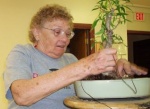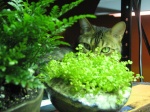Yamadori over nursery stock – The unfair advantage
+16
Dan Barton
MikeG
Robert J. Baran
Lee Kennedy
bonsaisr
craigw
Zach Smith
Kev Bailey
JimLewis
Rob Kempinski
jrodriguez
ogie
Dave Martin
Khaimraj Seepersad
fiona
Ravi Kiran
20 posters
Page 2 of 2
Page 2 of 2 •  1, 2
1, 2
 Re: Yamadori over nursery stock – The unfair advantage
Re: Yamadori over nursery stock – The unfair advantage
My questions to which I expect thoughtful responses
1. Does Yamadori give the bonsaist an unfair advantage over nursery stock
2. Can masterpieces be created from nursery stock within reasonable time
3. Should the source of the bonsai be displayed at exhibitions
4. These and any other thought of importance is most welcome…
Ravi
For what it's worth:
1. Yes, but only if the artist can actually continue nature's work with some hope of success. First, the tree must be kept alive. It's easy to neglect horticulture while working on your masterpiece. Second, nature has a lot of advantages over those of us who choose to step in and take over, namely time, infinite patience and the inherent artistic flair that drew us to the material in the first place. Finally, you don't see any "finished" bonsai in the wild (I'd nominate John Naka's demo winged elm at BCI 92, he ended up doing very little to it; no doubt there have been others); this means the artist has to complete what nature began, and this is far from assured.
2. Yes. Often this is accomplished with material from the "left over here in the corner to finish dying" section of the nursery. As in the wild, these trees range from hapless to pitiful, but you can clearly see the struggle they've had just to endure bad watering schedules or neglect or what have you. Sort of like what might have happened in nature, right? As for the rest, the answer is also yes but you have to be prepared to do the right thing depending on what you've got to work with. Small stock can usually benefit from a period in the ground. Larger stock with some potential generally just needs time and work.
3. Yes. If the tree is a great piece of yamadori that the artist has done well with, then the artist is going to say so. If the artist took a common piece of nursery stock and made something great out of it, then the artist is going to say it was nursery stock with pride. In non-competitive shows, artists are typically humble and mutually supportive, so this question becomes moot. If competition has reared its ugly head, then all bets are off.
4. I've personally collected a lot of material, and I do prefer it because nature has always had the advantage of time and "insight" I could not hope to match. I just limit myself to doing my best to continue the process and make a bonsai out of what nature was kind enough to provide.
Zach
Zach Smith- Member
 Re: Yamadori over nursery stock – The unfair advantage
Re: Yamadori over nursery stock – The unfair advantage
Hi Ravi, great thread with some very interesting posts. Here in Australia we don't have a lot of great yamadori material, our native trees with a few exceptions resent being moved, our alpine and sub-alpine areas are very much locked up in national parks. Most plant material that is collected for bonsai here are environmental weeds such as pinus radiata ,fraxinus ssp or olives
Lots of bonsai growers here develop stock from seed and cutting, there is no doubt that unless you take the shohin road this is a very long process. It is nevertheless sustainable and I am sure will be the future of bonsai internationally, the collection of trees from alpine and sub-alpine areas must eventually be outlawed it is an unsustainable practice.
The Japanese have an immense number of incredible bonsai which have been developed from seed and cutting, on Shikoku is the village of Kinashi where most of the pines are grown. There are nurseries there with thousands of pine bonsai all grown from seed.
I would hope that in the future the collection of wild trees will be frowned on the world is too small and the few wild places we have left should be preserved for future generations to enjoy.
Craigw
Lots of bonsai growers here develop stock from seed and cutting, there is no doubt that unless you take the shohin road this is a very long process. It is nevertheless sustainable and I am sure will be the future of bonsai internationally, the collection of trees from alpine and sub-alpine areas must eventually be outlawed it is an unsustainable practice.
The Japanese have an immense number of incredible bonsai which have been developed from seed and cutting, on Shikoku is the village of Kinashi where most of the pines are grown. There are nurseries there with thousands of pine bonsai all grown from seed.
I would hope that in the future the collection of wild trees will be frowned on the world is too small and the few wild places we have left should be preserved for future generations to enjoy.
Craigw
craigw- Member
 Yamadori, an unfair advantage?
Yamadori, an unfair advantage?
Actually, I have three trees you can call yamadori. One is a red maple I collected myself almost 20 years ago. I don't have much to show for it yet.
In North America, Larix laricina is a very popular bonsai subject. Virtually all of them are yamadori. Mine is a modest clump collected by Dave Easterbrook. I think it has a definite advantage over nursery stock & I am enjoying it. I doubt the supply will run out any time soon, but we should be prepared.
My third yamadori, if you can call it that, is a clump of naturalized Lonicera tatarica dug up by a friend of mine. It is in the ground for the winter & I haven't done anything with it yet. Nick Lenz wrote extensively on this species.
A little perspective here. There are other disadvantages that make lack of yamadori or the money to buy them pale in comparison. Old age (Harry Hirao notwithstanding), physical disability, and pressing family responsibilities are much more serious obstacles to bonsai success. A loving spouse, an outstanding and helpful teacher, and supportive buddies keep one going. Now kwitcherbellyaching about yamadori.
Iris
In North America, Larix laricina is a very popular bonsai subject. Virtually all of them are yamadori. Mine is a modest clump collected by Dave Easterbrook. I think it has a definite advantage over nursery stock & I am enjoying it. I doubt the supply will run out any time soon, but we should be prepared.
My third yamadori, if you can call it that, is a clump of naturalized Lonicera tatarica dug up by a friend of mine. It is in the ground for the winter & I haven't done anything with it yet. Nick Lenz wrote extensively on this species.
A little perspective here. There are other disadvantages that make lack of yamadori or the money to buy them pale in comparison. Old age (Harry Hirao notwithstanding), physical disability, and pressing family responsibilities are much more serious obstacles to bonsai success. A loving spouse, an outstanding and helpful teacher, and supportive buddies keep one going. Now kwitcherbellyaching about yamadori.
Iris

bonsaisr- Member
 Re: Yamadori over nursery stock – The unfair advantage
Re: Yamadori over nursery stock – The unfair advantage
here is the antidote,remember that flush of youthfull exuberance and come back down from the mountain tops,or as a more plain speaking man may say quit moaning start enjoying1950's cyclocross race

Lee Kennedy- Member
 Re: Yamadori over nursery stock – The unfair advantage
Re: Yamadori over nursery stock – The unfair advantage
Collected older landscape material (with appropriate permission) from demolition or renovation sites seems to be a reasonable blend of the best traits of yamadori and nursery stock. Some of us can even get a couple of "volunteer" plants from our own yards if we are patient.
As I sometimes tell especially novices: just as there are a few "show" dogs and many, many more "house" dogs, so too in our collections we may have a few "show" trees and many, many more "house" trees. You know, the bonsai-in-training that still have a year or several years of development, some of our earlier trees that we won't ever design into silk purses but that have survived our beginning attempts and have earned their room and board by just being stubborn and hardy. And the trees that just this past season we've started to successfully alter in the direction we want.
I look at the pictures of masterpiece trees and I ask myself "if I suddenly inherited or could afford such a tree tomorrow, would I be able to care for it properly?" Most of the time my answer would have to be "no." Primarily due to differences in weather/climate, resources/siting, enough experience.
I try to take a little bit of knowledge and thought from every tree I see in the many photos, few videos, and even fewer live shows/others' collections and try to incorporate the most stirring to me parts into the compositions I'm now designing. And those I will get in the future. (Same thing with learning from the trees I had in the past...)
As I sometimes tell especially novices: just as there are a few "show" dogs and many, many more "house" dogs, so too in our collections we may have a few "show" trees and many, many more "house" trees. You know, the bonsai-in-training that still have a year or several years of development, some of our earlier trees that we won't ever design into silk purses but that have survived our beginning attempts and have earned their room and board by just being stubborn and hardy. And the trees that just this past season we've started to successfully alter in the direction we want.
I look at the pictures of masterpiece trees and I ask myself "if I suddenly inherited or could afford such a tree tomorrow, would I be able to care for it properly?" Most of the time my answer would have to be "no." Primarily due to differences in weather/climate, resources/siting, enough experience.
I try to take a little bit of knowledge and thought from every tree I see in the many photos, few videos, and even fewer live shows/others' collections and try to incorporate the most stirring to me parts into the compositions I'm now designing. And those I will get in the future. (Same thing with learning from the trees I had in the past...)

Robert J. Baran- Member
 Re: Yamadori over nursery stock – The unfair advantage
Re: Yamadori over nursery stock – The unfair advantage
The world is too full of examples of things which do run out whether it be western plains bison in the USA, eastern spotted quoll in Australia or orchids in Kalimantan seemingly inexhaustible supplies of wild things do disappear. I know at present the numbers collected in most areas is relatively small but will it stay that way ?
Craig
Craig
craigw- Member
 Re: Yamadori over nursery stock – The unfair advantage
Re: Yamadori over nursery stock – The unfair advantage
Hi everyone, great topic. I am 33 yrs old and just got into bonsai at the beginning of this growing season. I've been into horticulture and the visual arts for many yrs but have never combined the two until now. I really do wish I had got into it at a younger age but I cant turn back the clock so I'll have to do the most with what time Ive got. I have aquired many nursery and pre bonsai specimens this season and started many seedlings as well. If presented with a quality yamadori in my budget I would jump at it. That being said, There is something very satisfying from nurturing a plant from seed. Even with my flowers and veggies, I find they smell, look and taste better when I bring them into this world instead of buying an already established plant and just planting it. I repotted many of my seedlings after a few sets of true leaves were out, cutting back the taproot and spreading out lateral roots, setting them on there path to becoming bonsai in the future. I may be 60, 70 or 80 years old until I get a 'show ready' tree from any of them, but it's the journey and growing together that I think will be the most satisfying.
On the side of yamadori, there is something very alluring about the prospect of exploring the wilderness for a beautiful, mother nature crafted specimen and bringing to its fullest so everyone can enjoy it. I like to think of it as paying homage to the first practitioners of the art, so long ago in China, who journeyed far and wide to collect trees from nature and began this fascinating artform.
Just a newbies point of view
Thanks, Mike
On the side of yamadori, there is something very alluring about the prospect of exploring the wilderness for a beautiful, mother nature crafted specimen and bringing to its fullest so everyone can enjoy it. I like to think of it as paying homage to the first practitioners of the art, so long ago in China, who journeyed far and wide to collect trees from nature and began this fascinating artform.
Just a newbies point of view
Thanks, Mike

MikeG- Member
 Re: Yamadori over nursery stock – The unfair advantage
Re: Yamadori over nursery stock – The unfair advantage
Mike,
33 + 10 = 43
33 + 20 = 53
200 to 100 trees in training --- > possibility of 10 exceptional - 40 good - 40 fair.[ give fair to someone around 23 to 33 years old ]
May sensible choices from now. Canada - pine - maple - juniper - elm [ zelkova ] - and say 10 experimental - you will be just fine.
Pine from seed is possible see Bonsai Today early issues. With your zone, they may be wintered in an unheated garage, if need be.
Yamadori [ exceptional to good ] 10 to 20 years to bring into balance. Same khaki pants.
Sensible choices,over the experimental.
Later.
Khaimraj
33 + 10 = 43
33 + 20 = 53
200 to 100 trees in training --- > possibility of 10 exceptional - 40 good - 40 fair.[ give fair to someone around 23 to 33 years old ]
May sensible choices from now. Canada - pine - maple - juniper - elm [ zelkova ] - and say 10 experimental - you will be just fine.
Pine from seed is possible see Bonsai Today early issues. With your zone, they may be wintered in an unheated garage, if need be.
Yamadori [ exceptional to good ] 10 to 20 years to bring into balance. Same khaki pants.
Sensible choices,over the experimental.
Later.
Khaimraj

Khaimraj Seepersad- Member
 Re: Yamadori over nursery stock – The unfair advantage
Re: Yamadori over nursery stock – The unfair advantage
Zach,
Thanks for the very thoughtful contribution. What you say is very valid and I agree with the same.
Craig,
Thanks for your post. Good to know how Bonsai is approached to down under. Especially when yamadori actually helps the environs… well that is a true win-win
Iris
Thanks a ton for bringing up the very important aspect of the support framework for successful bonsai. The importance of age, health and family and friend support. Well I’d say that these are the very foundations on which does develop great bonsai. Harry Hirao continues to defy age and create masterpieces in his 90s. I’d want him to do keep doing the same even after he hits a century…
Robert
Thanks for putting into perspective why sub-standard plants continue to occupy prominent positions in our bonsai gardens. As you correctly put it the very fact that they have survived over the years is a claim to fame in our minds and for the others, well nostalgia of where it came from or if the tree was among the first few or for any other nostalgic reason. I have begun to let quality overrule nostalgia and have either reworked(ing) on the hopeful ones and discarding the hopeless ones.
Mike
Welcome aboard to the fascinating world of bonsai. One of the first few and probably the most important things I have learnt in bonsai are patience and a plan. You seem to have taken hold on the patience bit – Congrats. On the plan bit keep working and over time I am sure you’d create trees that you’d enjoy and share with pride
Regards to all
Ravi
Thanks for the very thoughtful contribution. What you say is very valid and I agree with the same.
Craig,
Thanks for your post. Good to know how Bonsai is approached to down under. Especially when yamadori actually helps the environs… well that is a true win-win

Iris
Thanks a ton for bringing up the very important aspect of the support framework for successful bonsai. The importance of age, health and family and friend support. Well I’d say that these are the very foundations on which does develop great bonsai. Harry Hirao continues to defy age and create masterpieces in his 90s. I’d want him to do keep doing the same even after he hits a century…
Robert
Thanks for putting into perspective why sub-standard plants continue to occupy prominent positions in our bonsai gardens. As you correctly put it the very fact that they have survived over the years is a claim to fame in our minds and for the others, well nostalgia of where it came from or if the tree was among the first few or for any other nostalgic reason. I have begun to let quality overrule nostalgia and have either reworked(ing) on the hopeful ones and discarding the hopeless ones.
Mike
Welcome aboard to the fascinating world of bonsai. One of the first few and probably the most important things I have learnt in bonsai are patience and a plan. You seem to have taken hold on the patience bit – Congrats. On the plan bit keep working and over time I am sure you’d create trees that you’d enjoy and share with pride
Regards to all
Ravi

Ravi Kiran- Member
 Re: Yamadori over nursery stock – The unfair advantage
Re: Yamadori over nursery stock – The unfair advantage
Hi Ravi,
What a very interesting discussion your topic has raised — so many words of wisdom written with such eloquence and astute observation relating to trees grown from yamadori or other more humble sources. Everyone's comments seem to be entirely valid for all of the reasons given so I find it hard to resist the opportunity to toss in my penny's worth. Bonsai was, is, and always will be for me an opportunity to engage with nature through a period of time and to afford me the opportunity for creative expression. It is essentially an involvement with life, trees, love and people and it is of no consequence to me whether my bonsai have been created from yamadori or seed, cuttings, layerings etc. These sources are purely the sources of 'artist' material and each source of material tree will provide its encumbent challenges. Yamadori's main advantage is that so much of the hard work has been achieved by Mother Nature and because of the austere environments from whence the material has been collected, many very visually dramatic effects can be found in the mountains. And of cause the the other major advantage is the speed by which an exhibitable specimen bonsai can be created.
Bonsai created from yamadori sources have over the past 25 years dominated the show benches and taken most of the awards and so many of the articles featured in the bonsai magazines and forums of today have featured trees being transformed into bonsai from yamadori so it's not difficult to feel a little conditioned into thinking that yamadori is the 'be all and end all' of bonsai — it isn't — it's just one source of suitable material.
How many of the great Japanese masterpiece zelkovas, elms, beech, stewartias etc have come from yamadori — precious few, if any at all. These trees have been cultivated from seedlings, cuttings, layerings etc over significant periods of time. "TIME", that commodity that is so precious to us all in this day and age of "rush", so growing trees from humble beginnings really does test our dedication and commitment. However, there are many trees around the world that have been grown from very humble beginnings, and in an effort to showcase some of these 'beauties' I'm hosting a website dedicated to doing just this and would urge anyone with bonsai that have reached specimen status to send me pictures of their trees for posting on the site: http://ourbonsai.wordpress.com
Hopefully, this will demonstrate what can be achieved with time,patience and dedication. It's time some attention was paid to these totally man/woman created bonsai and to give yamadori a little rest — at least for a few years. So Ravi, take heart and do keep up with your bonsai however humble their beginnings.
What a very interesting discussion your topic has raised — so many words of wisdom written with such eloquence and astute observation relating to trees grown from yamadori or other more humble sources. Everyone's comments seem to be entirely valid for all of the reasons given so I find it hard to resist the opportunity to toss in my penny's worth. Bonsai was, is, and always will be for me an opportunity to engage with nature through a period of time and to afford me the opportunity for creative expression. It is essentially an involvement with life, trees, love and people and it is of no consequence to me whether my bonsai have been created from yamadori or seed, cuttings, layerings etc. These sources are purely the sources of 'artist' material and each source of material tree will provide its encumbent challenges. Yamadori's main advantage is that so much of the hard work has been achieved by Mother Nature and because of the austere environments from whence the material has been collected, many very visually dramatic effects can be found in the mountains. And of cause the the other major advantage is the speed by which an exhibitable specimen bonsai can be created.
Bonsai created from yamadori sources have over the past 25 years dominated the show benches and taken most of the awards and so many of the articles featured in the bonsai magazines and forums of today have featured trees being transformed into bonsai from yamadori so it's not difficult to feel a little conditioned into thinking that yamadori is the 'be all and end all' of bonsai — it isn't — it's just one source of suitable material.
How many of the great Japanese masterpiece zelkovas, elms, beech, stewartias etc have come from yamadori — precious few, if any at all. These trees have been cultivated from seedlings, cuttings, layerings etc over significant periods of time. "TIME", that commodity that is so precious to us all in this day and age of "rush", so growing trees from humble beginnings really does test our dedication and commitment. However, there are many trees around the world that have been grown from very humble beginnings, and in an effort to showcase some of these 'beauties' I'm hosting a website dedicated to doing just this and would urge anyone with bonsai that have reached specimen status to send me pictures of their trees for posting on the site: http://ourbonsai.wordpress.com
Hopefully, this will demonstrate what can be achieved with time,patience and dedication. It's time some attention was paid to these totally man/woman created bonsai and to give yamadori a little rest — at least for a few years. So Ravi, take heart and do keep up with your bonsai however humble their beginnings.

Dan Barton- Member
 Re: Yamadori over nursery stock – The unfair advantage
Re: Yamadori over nursery stock – The unfair advantage
Thanks Dan for the words of encouragement. Certainly am at it for good. Learning more along the way and enjoying it.
Regards
Ravi
Regards
Ravi

Ravi Kiran- Member
 Re: Yamadori over nursery stock – The unfair advantage
Re: Yamadori over nursery stock – The unfair advantage
The only really big secret here is the big trunk, and how to keep it other than straight. True appearance of age can only come with time and or[ gibberellic acid [ on rough trunks.]]
So you ground grow or study one of the Japanese techniques using pots.[ See Bonsai Today ]
Of course if you are into jins and other, yamadori or phoenix grafts.
Most shoot their own foot with either too small pots for growing on or putting things into Bonsai pots prematurely [ unless they have really big Bonsai pots .]
Now go out there and grow the big twisted trunks.
Khaimraj
*If you use seeds or cuttings, planned drawings help. Remember airlayers as well.
So you ground grow or study one of the Japanese techniques using pots.[ See Bonsai Today ]
Of course if you are into jins and other, yamadori or phoenix grafts.
Most shoot their own foot with either too small pots for growing on or putting things into Bonsai pots prematurely [ unless they have really big Bonsai pots .]
Now go out there and grow the big twisted trunks.
Khaimraj
*If you use seeds or cuttings, planned drawings help. Remember airlayers as well.

Khaimraj Seepersad- Member
 Re: Yamadori over nursery stock – The unfair advantage
Re: Yamadori over nursery stock – The unfair advantage
Hello Dan. Just had a look at the Ourbonsai site and what an excellent idea it is. Trees created from more humble backgrounds but true masterpieces without a doubt. I for one will be offering some pictures to the site.
Guest- Guest
 Re: Yamadori over nursery stock – The unfair advantage
Re: Yamadori over nursery stock – The unfair advantage
I'm delighted to hear this Will and I do hope many more people from all over the world will also contribute images for the site. I have no problem with yamadori trees and have several of my own but I do feel that the bonsai shows seem to give them more bench space and tend to neglect the bonsai created from humbler beginnings. I certainly glean far more satisfaction from bonsai that I have created from seed, cuttings etc than I do from my yamadori trees as I feel that I can claim all of the credit without having to bow to Nature's sublime and artistic hand. The one thing that is hard to compete with, with Nature, is the ability to achieve ancient and mature trunks.... this can seem to take an eternity of time!

Dan Barton- Member
 unfair advantage
unfair advantage
what a great debate,as a novice to bonsai i read all with interest,i myself started bonsai for satisfaction and to challenge myself into creating something of beauty,im not interested in being a master,i am learning by asking and a great deal of reading,if at the end of the day i can produce a artistic piece of work then im happy(in my eyes) Does a bonsai have to conform,in my view trees come in all shapes and sizes,so to that end i am not going to loose sleep if the tree is a bit wonky or what ever,it will still receive the same love and care i can possibly give,to me there is no advantage in bonsai just great satisfaction.Yes i know just like anything you will get people who want to be the best and some who will cheat or spend loads of money to get there but hey thats life,and last but not least i am 54 and just started up,so you young ones thats unfair advantage lol!! To that end im not going to start a bonsai from seed. cheers all steve
stephen clarke- Member
 Re: Yamadori over nursery stock – The unfair advantage
Re: Yamadori over nursery stock – The unfair advantage
54!
A mere spring chicken!
Saburo Kato the Japanese master was planting black pine seeds at the age of 94.
A mere spring chicken!
Saburo Kato the Japanese master was planting black pine seeds at the age of 94.

Dave Martin- Member
 Re: Yamadori over nursery stock – The unfair advantage
Re: Yamadori over nursery stock – The unfair advantage
I, a beginner like Stephen and almost at his age, can say "Thank you" to all the contributors in this thread for their encouraging points of view.
We beginners, feel so much in a rush to achieve something of quality standard that sometimes we end up feeling hopeless and disappointed....
I do agree in the utmost degree with Will and Fiona:
Thank you all once again!
We beginners, feel so much in a rush to achieve something of quality standard that sometimes we end up feeling hopeless and disappointed....
I do agree in the utmost degree with Will and Fiona:
will baddeley wrote: ... ... but the journey I have taken with my trees, from collection, through styling, to exhibition and all my own work, is priceless.
and really feel much obliged to Dan Barton for his thoughts:fiona wrote: ... ... The bottom line for me is that bonsai is about the person who is doing the creating - it matters not whether that person calls themself artist, hobbyist or even novice. Without that person's effort creativity (and, don't forget, the long term care and maintenance aspect) even the best quality yamadori will come to nothing… …
and for the creation of the specific site where material for dreaming and projects and expectations can be found....Dan Barton wrote: ... ... "TIME", that commodity that is so precious to us all in this day and age of "rush", so growing trees from humble beginnings really does test our dedication and commitment. ... ... It's time some attention was paid to these totally man/woman created bonsai and to give yamadori a little rest — at least for a few years. So Ravi, take heart and do keep up with your bonsai however humble their beginnings.
Thank you all once again!

my nellie- Member
 Re: Yamadori over nursery stock – The unfair advantage
Re: Yamadori over nursery stock – The unfair advantage
Hi Stephen,
Several years ago I conducted a series of bonsai workshops in the US and one was in Florida where one of the participants was 92 years old..... I am 72 (going on 12!) so I envy you at 54. Incidentally, I just planted several dozen maple seeds a couple of days ago. Beautiful forest groups can be created from relatively young saplings.... it's not all about ancient knarly trunks!
Several years ago I conducted a series of bonsai workshops in the US and one was in Florida where one of the participants was 92 years old..... I am 72 (going on 12!) so I envy you at 54. Incidentally, I just planted several dozen maple seeds a couple of days ago. Beautiful forest groups can be created from relatively young saplings.... it's not all about ancient knarly trunks!

Dan Barton- Member
 Re: Yamadori over nursery stock – The unfair advantage
Re: Yamadori over nursery stock – The unfair advantage
I'm a year older than Dan, and I just gathered some seed off a plant found growing along the banks of one of our small rivers where I walk most every day (eight %$#$#@ inches of snow on the ground today, so no walk!). I'll plant these if this winter ever ends.

JimLewis- Member
 Re: Yamadori over nursery stock – The unfair advantage
Re: Yamadori over nursery stock – The unfair advantage
Great read guys! I'm 60 and have been involved in some form of the nursery trade for 45 years and bonsai for 25(guessing). As much as I love working on high level trees, propagating and growing is my passion. Bonsai enjoyment is sooooo varied I sometimes get "put off" by some that expect that their way is the only way. I hope to still be growing seeds and taking cuttings when I'm 100 
Wood
http://thingsofwood-gary.blogspot.com/
Wood
http://thingsofwood-gary.blogspot.com/
GaryWood- Member
 Re: Yamadori over nursery stock – The unfair advantage
Re: Yamadori over nursery stock – The unfair advantage
Hi Gary,
Very interesting blogsite and you are certainly getting some spectacular nebari development on your trees.
Very interesting blogsite and you are certainly getting some spectacular nebari development on your trees.

Dan Barton- Member
 Re: Yamadori over nursery stock – The unfair advantage
Re: Yamadori over nursery stock – The unfair advantage
O.K.i get the message,54 is young well its seems that way judging by the comments (nice ones)at the end of the day i love my new hobby a lot more relaxing than life in the forces,i will grow old with my wife and tees in that order(she told me to say that) steve
stephen clarke- Member
 pre bonsai cedar of lebanon
pre bonsai cedar of lebanon
Does anyone know of a source for a pre bonsai cedar of Lebanon?
Thanks
Thanks
dstr- Member
Page 2 of 2 •  1, 2
1, 2
 Similar topics
Similar topics» My first nursery stock
» Bonsai from nursery stock
» Boxwood from nursery stock
» when to shop for nursery stock
» birch nursery stock
» Bonsai from nursery stock
» Boxwood from nursery stock
» when to shop for nursery stock
» birch nursery stock
Page 2 of 2
Permissions in this forum:
You cannot reply to topics in this forum






